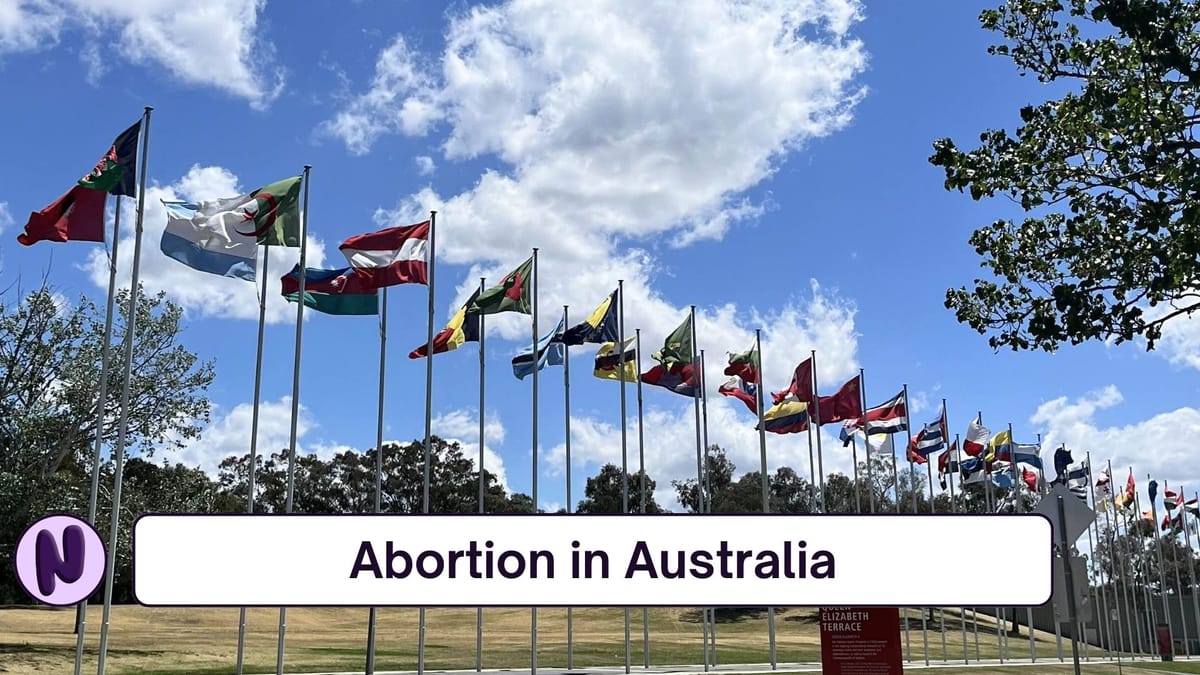Abortion in Australia
CONTENT WARNING: Discussions of abortion, newborn and infant palliative care and death, and birth trauma

While Australians come together to mourn the victory of the Republican Party in the recent United States election, we mustn't turn a blind eye to the very real threats to our human rights being legislated on in our states and territories as we speak.
Reproductive rights were at the forefront of many voters, and non-voters, minds during this Presidential election, and for good reason. The last four years have seen an unconscionable rolling-back of the hard-won rights to safe and legal abortion in the United States, ‘starting’ (though the pro-life movement has never truly stopped trying to take our rights away) with the Texas Heartbeat Act passed in 2021, which banned abortions after six weeks, with no exceptions for rape or incest. Since the overturning of Roe v Wade, a case which had provided a constitutional right to abortion since 1973, in June of 2022, the right to reproductive care has become a State issue. In the two years that have followed this tragic overturning, a further twenty US States have passed similar Acts to heavily restrict, or ban outright, abortion procedures earlier in pregnancy than the standard set by Roe v Wade.
With Trump now set to return to office, the looming danger of Project 2025 promises only more restrictions on the reproductive rights of US citizens and residents. The Heritage Foundation’s 900-page “wish list” for the next Republican president contains about 200 mentions of abortion, and, though it doesn’t call for an outright nationwide ban, does make clear the intention to surely and steadily remove access to abortion procedures. This includes plans to block access to the abortion pill mifepristone, and, in the words of Vice-President Harris, introduce “a national monitor that would be monitoring your pregnancies, your miscarriages.”
These proposed changes are, of course, horrifying, and the fear and apprehension faced by US citizens and residents cannot be understated. However, whilst we turn our minds to our friends on the other side of the globe, it is crucial we do not forget the fight still waging back home.
Australia is, comparatively, fairly behind on the times when it comes to the protection of reproductive rights. Until 1969, abortion was illegal in Australia, and Indigenous women and people with disabilities faced issues including forced sterilisation, and state-enforced removal of children, which still occurs today. The ACT was the first territory to decriminalise abortion in 2002, with other states and territories lagging far, far behind: Victoria in 2008, Tasmania in 2013, Northern Territory in 2017, Queensland in 2018, NSW in 2019, South Australia in 2020, and, finally, Western Australia in 2023. When the Australian Labor Party revealed a national abortion policy for the 2019 Federal election, Liberal Party leader Scott Morrison and anti-abortion groups including the Australian Christian Lobby and Cherish Life campaigned against Labor and ultimately prevented the policy from ever being enacted. Like the United States, there is no nationwide protection of reproductive rights. Like the United States, abortion access is governed by the states and territories. Like the United States, this is a slippery slope to their outright elimination.
If there’s one thing Australian politicians enjoy more than shitting their pants at chain restaurants, it’s copying the United States. In the tidal wave that was the leadup to the US presidential election, reproductive rights also made an appearance in the Queensland state election last fortnight. In the leadup to the state election, Katter's Australian Party leader Robbie Katter (yes, Bob Katter’s son) claimed his party would take an abortion repeal bill to Queensland parliament “quick as you like” after the election. This bill would attempt to “ensure the rights of babies born alive” during an abortion, so, as Katter claims - though it’s a surprise anyone can hear him from under that giant hat - “they’re not thrown in waste bins, and that they're not left to die on a table with no warmth or care”. Speakers on the motion quoted maternity nurse Louise Adsett’s claims of babies “left to cry themselves to death, alone . . . babies that have been marked for death.” Further claims were made that “the health of the mother is the same, no matter if the baby is put up for adoption or murdered” in a frankly pathetic attempt to delegitimise reproductive care and abortion access as an integral part of the women’s health sector.
Katter’s failed 2022 bill, which he intends to repackage in 2025, references statistics pulled from Queensland Health’s Perinatal Annual Reports for 2010–2020. At first glance, the statistics do appear concerning. The statistics he mentions report the conditions for perinatal deaths, perinatal referring to the period of time when you become pregnant and up to a year after giving birth. One of the conditions listed is the termination of a pregnancy, fetus, or newborn. Now, even I took pause when I read this. Termination of a newborn? Is Robbie Katter right? Are they killing babies right under our noses, and was our left-wing brainwashing preventing us from seeing the truth?
Obviously, Katter is not correct, and his concerns, along with my own, stemmed from a lack of understanding and education surrounding the terms used in this report. The American College of Obstetricians and Gynecologists explains that the ‘termination’ of a neonatal (newborn) or perinatal (under a year old) baby is, in fact, palliative, or end-of-life, care, that “centers on maximizing quality of life and comfort for newborns who have life-limiting conditions in early infancy”. These life-limiting conditions are incurable, of severe morbidity, and cause extremely poor quality of life. While perinatal palliative care may be delivered alongside life-prolonging treatment, many patients choose not to pursue these other treatments, because they are too invasive or complex, because they pose higher risks of harm, because they have uncertain outcomes, or because they do not align with the patient’s values or priorities for their families.
Armed with this knowledge, the reports from Louise Adsett, as emotionally manipulative and ill-informed as they are, become far more heartwarming. She describes nurses comforting and holding infants as they draw their final breaths, honouring the chief aim of perinatal palliative care, to alleviate the newborn’s suffering, and support the newborn’s parent or parents.
To make it perfectly clear, however, at no point in the course of delivering a newborn with life-limiting conditions and providing palliative care does a medical professional end the life of the newborn. Such claims are not only poorly educated and ignorant, they are dangerous, to the freedoms of parents making one of the most difficult decisions imaginable, and to the right to access safe abortion and other reproductive care.
While Liberal National Party candidates claim they have no plans to re-criminalise abortion, an overwhelming majority of the LNP members elected in 2024 are the same who voted against Labor's 2018 abortion bill. With 50 seats between the two parties, a “conscience vote” could easily get Katter’s bill over the line.
A similar bill was narrowly shot down in South Australia in mid-October. South Australia’s upper house held a conscience vote - the same vote Katter’s bill calls for - on legislation that would force women seeking an abortion after 28 weeks to be induced and deliver the child alive, and either keep it or adopt it out. Liberal frontbencher Ben Hood, who introduced the bill, claims that the bill continues to protect a women’s right to end a pregnancy because the pregnancy ends when the baby is born, “The innovation of this bill is that it allows a mother to end her pregnancy throughout all nine months and indeed right up to birth.” Not only is this a gross misrepresentation of the right to abortion, it undermines the severity of the physical and psychological trauma giving birth can cause. The International Journal of Obstetrics & Gynaecology reports that every year, around one in four first-time mothers, between 15,000 and 30,000 women in Australia per year, suffer major irreversible physical birth trauma. Research from the Australian College of Midwives suggests 1 in 3 births are psychologically traumatic, and about 4% of women and 1% of their partners develop post-traumatic stress disorder as a result.
Approximately 1% of all abortions are carried out after 20 weeks - they are most commonly performed in the first 12 weeks. There are two different types of abortion; medical, usually where a pill is taken orally in the first 9 weeks of pregnancy; or surgical, where a medical procedure is undertaken to remove the foetus from the uterus. According to SA Health, fewer than five abortions have been performed after 27 weeks in the last 18 months. The approval of two doctors is needed for terminations at that stage, and can only be done if it is necessary to save the life of the pregnant person or another foetus, if it poses a significant risk of physical or psychological trauma, or if there is a significant risk of serious foetal anomalies. Hood previously stated that, once born, if the baby “isn’t compatible with life”, it would then be given palliative care. Under Katter’s legislation, this would not be permitted.
The bill in South Australia was narrowly defeated, with nine votes in favour, and only ten votes against. This is in an upper house with a narrow majority of Labor and Greens representatives.
What these right-wing activists seem incapable of understanding, is that the decision to have an abortion is never, ever, taken lightly by the person making it. The false rhetoric that women are simply wandering their way into clinics to bump off their third baby of the week fails to recognise the intense physical and psychological effects that such procedures have, and the mental and emotional turmoil that people face when choosing to terminate a pregnancy. This is all the more prevalent in the late-stage abortions and palliative care which these bills, bills which echo sentiments from contemporaries in the United States, are attempting to eradicate.
Last month, healthcare groups issued an open letter calling Australian politicians to protect abortion rights and to treat abortion as health care. The letter, co-signed by RANZCOG and RACGP, as well as Children by Choice, Women's Health Services Alliances, Queensland Sexual Assault Network, and others, is as heartbreaking as it is powerful. “We are deeply concerned by recent discussions suggesting the potential re-criminalisation of abortion.” The letter reads, “This would be a harmful step backward, risking the health and safety of pregnant people and undoing years of progress. Access to abortion is essential health care. Restricting it leads to dangerous consequences, with vulnerable communities facing the greatest harm. We must ensure that decisions about pregnancy remain personal and healthcare-based, not politicised.”
As we stand in solidarity with the United States, and brace for the oncoming storm that will be a second Trump presidency, it is important that we continue to fight for our own rights here in Australia. The decades of activism and protest and lobbying governments that have finally won us the right to safe and decriminalised abortion in every state cannot fall by the wayside. We have to continue to advocate for our rights to freedom and bodily autonomy. In the U.S., despite Trump's success across the Senate, House of Representatives and in the Presidential race, seven states passed ballot measures protecting the right to an abortion despite Trump's wider success. Even 57% of Floridians voted in favour of the right to an abortion, however, this did not pass Florida’s 60% requirement for ballot measures. The fight is not over, it’s only just begun.
Just this morning, documents leaked to the ABC revealed staff at Orange Health Service in NSW could no longer provide abortions for patients with “no identified pregnancy complications”. As ABC reports, “earlier this year, Orange Hospital's executive issued a verbal directive to stop providing terminations for non-medical reasons. Since then, the executive had been 'slowly tightening the screws' to further restrict the service.” While abortion services were set to be restored in the hours following ABC’s article and a brief statement from NSW Health Minister Ryan Park, the incident proves the very real power that conservative executives can wield to restrict abortion access in the rural communities who need it most.
Katter, Hood, and right-wing politicians and executives around Australia, will not stop at preventing perinatal palliative care and late-term abortion. They will not stop until they have rolled back abortion access entirely. So we cannot stop until our rights are secured, and we hope that the growing movement of protestors in red capes and white caps will not become a reality.



